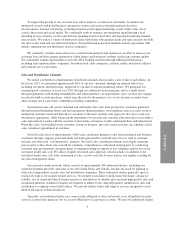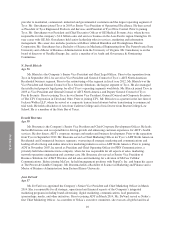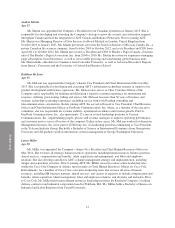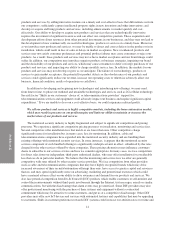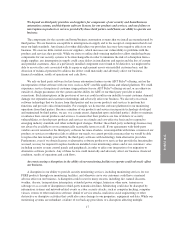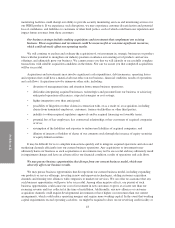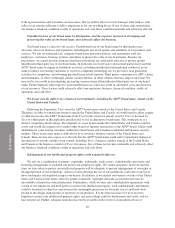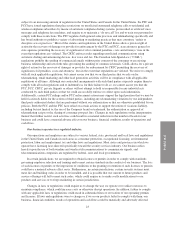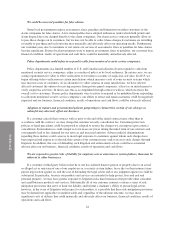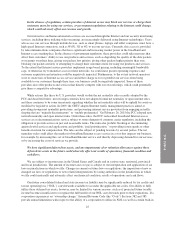ADT 2015 Annual Report Download - page 89
Download and view the complete annual report
Please find page 89 of the 2015 ADT annual report below. You can navigate through the pages in the report by either clicking on the pages listed below, or by using the keyword search tool below to find specific information within the annual report.
FORM 10-K
the risk of accelerated amortization of customer contracts resulting from a declining customer base. It is possible
that one or more of our competitors could develop a significant technological advantage over us that allows them
to provide additional service or better quality service or to lower their price, which could put us at a competitive
disadvantage. Continued pricing pressure, improvements in technology and shifts in customer preferences
towards self-monitoring or DIY could adversely impact our customer base and/or pricing structure and have a
material adverse effect on our business, financial condition, results of operations and cash flows.
We rely on a significant number of our customers remaining with us as customers for long periods of
time.
We operate our business with the goal of retaining customers for long periods of time in order to recoup our
initial investment in new customers, and we generally achieve cash flow break-even in approximately three
years. Accordingly, our long-term profitability is dependent on long customer tenure. This requires that we
minimize our rate of customer disconnects, or attrition. One reason for disconnects is when customers relocate
and do not reconnect. Customer relocations are impacted by changes in the housing market. See risk factor
“General economic conditions can affect our business and we are susceptible to changes in the housing market
and consumer discretionary income, which may inhibit our ability to sustain customer base growth rates.” Other
factors that can increase disconnects include problems experienced with our product or service quality, customer
service, customer non-pay, unfavorable general economic conditions, and the preference for lower pricing of
competitors’ products and services over ours. If we fail to keep our customers for a sufficiently long period of
time, our profitability, business, financial condition, results of operations and cash flows could be materially and
adversely affected.
If we experience significantly higher rates of customer attrition, we may be required to change the
estimated useful lives of assets and/or the accelerated method of depreciation related to our security
monitoring customers, increasing our depreciation and amortization expense or impairing such assets.
We amortize the costs of our acquired and dealer-generated contracts and related customer relationships
based on the estimated life of the customer relationships. We similarly depreciate the cost of our internally
generated residential and business monitoring system assets and deferred subscriber acquisition costs. If attrition
rates were to rise significantly, we may be required to accelerate the amortization of expenses related to such
contracts and the depreciation/amortization of our subscriber system assets/deferred subscriber acquisition costs
or to impair such assets, which could cause a material adverse effect on our financial condition and results of
operations.
General economic conditions can affect our business and we are susceptible to changes in the housing
market and consumer discretionary income, which may inhibit our ability to sustain customer base
growth rates.
Demand for alarm monitoring services and home automation systems is affected by the turnover in the
housing market. Downturns in the rate of the sale of new and existing homes, which we believe drives a
substantial portion of our new customer volume in any given year, would reduce opportunities to make sales of
new security and home automation systems and services and reduce opportunities to take over existing security
and home automation systems. Recoveries in the housing market increase the occurrence of relocations which
may lead to customers disconnecting service and not contracting with us in their new homes. In addition, general
economic conditions can affect our business. For example, changes in personal economic circumstances may
cause current security alarm and home automation customers to disconnect our services in an effort to reduce
their monthly spending and such customers may default on their remaining contractual obligations to us. Our
long-term revenue growth rate depends on installations exceeding disconnects. If customer disconnects and
defaults increase, our business, financial condition, results of operations and cash flows could be materially and
adversely affected. See risk factor “We rely on a significant number of our customers remaining with us as
customers for long periods of time.”
15


